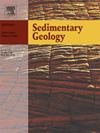阿拉伯板块东北缘白垩系沉积相结构受构造游动和盆地形态的控制
IF 2.9
2区 地球科学
Q1 GEOLOGY
引用次数: 0
摘要
基底隆起及其邻近盆地是控制区域相构型的重要构造要素。由于海平面的波动,从波峰到侧面环境的相单元的对比往往具有挑战性。本文以阿拉伯板块东北缘上turonian -下Campanian古隆起为例。两个地层剖面(分别为察鸿和卡孜)比较了峰侧和翼侧的沉积二分法。古高贾鲁姆剖面记录了一个不断加深的向上演替,包括底部的微咸碳酸盐,其次是浅海碳酸盐,最后是盆地沉积。卡子剖面(侧翼)的三东系沉积记录包括地层厚度较厚的钙质积岩、钙质碎屑岩、滑塌褶皱、斜形岩和河道充填沉积,它们整合于深水沉积之上。这个案例研究提供了对特提斯王国很少记录的过程的见解。这里显示的数据举例说明了区域隆起(与构造反转有关)与海平面上升变化之间的相互作用。相结构的区域对比突出了受与古隆起几何形状相关的测深和海底倾角控制的相和地层厚度的重要横向变化。我们认为,这里描述的再沉积碳酸盐岩具有沿斜坡构造活动层段的特征。此外,我们还证明,在无边缘的、远端变陡的斜坡上,持续的碳酸盐生产支持了钙化塑料的沉积。所提供的数据对于理解沿阿拉伯边缘及更远的白垩纪碳酸盐岩体系的再沉积过程至关重要。本文章由计算机程序翻译,如有差异,请以英文原文为准。
Tectono-eustasy and basin morphology controls on Cretaceous facies architecture in the northeastern margin of Arabian Plate
Basement highs and adjacent basins are significant structural elements controlling regional facies architecture. Overprinted by fluctuating sea-levels, the correlation of facies units from the crest into the flank environments is often challenging. Here, a case example of an upper Turonian–lower Campanian palaeohigh on the northeastern margin of the Arabian Plate is presented. Two stratigraphic sections (Jarhum and Qazi, respectively) compare the depositional dichotomy between crest and flank. The palaeohigh Jahrum section documents a deepening upward succession that includes brackish carbonates at the base, followed by shallow–marine carbonates, and culminates in basinal deposits. The sedimentary record of Santonian deposits in the Qazi section (flank) comprises stratigraphically thick calciturbidites, calcidebrites, slump folding, clinoforms, and channel-fill deposits, which conformably overlie deep-water deposits. This case study provides insights into processes that are rarely documented in the Tethyan realm. Data shown here exemplify the interaction between regional uplift (related to tectonic inversion) and eustatic sea–level changes. The regional correlation of the facies architecture highlights important lateral variations in facies and stratigraphic thickness controlled by bathymetry and seafloor inclination related to the geometry of the palaeohigh. We suggest that the redeposited carbonates described here are characteristic of tectonically active intervals along slope settings. Furthermore, we demonstrate that sustained carbonate production on unrimmed, distally steepened ramps supports the deposition of calciclastics. The data presented are crucial for understanding redeposition processes in Cretaceous carbonate systems along the Arabian margin and beyond.
求助全文
通过发布文献求助,成功后即可免费获取论文全文。
去求助
来源期刊

Sedimentary Geology
地学-地质学
CiteScore
5.10
自引率
7.10%
发文量
133
审稿时长
32 days
期刊介绍:
Sedimentary Geology is a journal that rapidly publishes high quality, original research and review papers that cover all aspects of sediments and sedimentary rocks at all spatial and temporal scales. Submitted papers must make a significant contribution to the field of study and must place the research in a broad context, so that it is of interest to the diverse, international readership of the journal. Papers that are largely descriptive in nature, of limited scope or local geographical significance, or based on limited data will not be considered for publication.
 求助内容:
求助内容: 应助结果提醒方式:
应助结果提醒方式:


